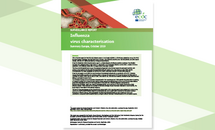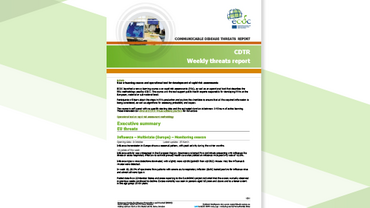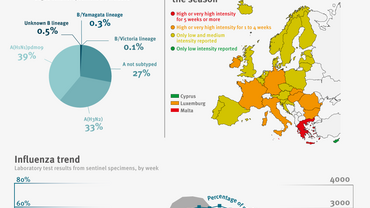Influenza virus characterisation, October 2019
This is the first report for the 2019–20 influenza season.
Executive Summary
As of week 44/2019, 1 138 influenza detections across the WHO European Region had been reported; 80% type A viruses, with A(H3N2) prevailing over A(H1N1)pdm09, and 20% type B viruses, with 26 of 27 (96%) ascribed to a lineage being B/Victoria. Since the September 2019 characterisation report1, a single shipment of influenza-positive specimens from EU/EEA countries was received at the London WHO CC, the Francis Crick Worldwide Influenza Centre (WIC). A total of 15 virus specimens, with collection dates after 31 August 2019, have been received. The three A(H1N1)pdm09 test viruses characterised antigenically since the last report showed good reactivity with antisera raised against both the A/Brisbane/02/2018 2019–20 vaccine virus. The single virus for which genetic characterisation has been completed carried the HA1 S183P substitution and fell in the 6B.1A5B subgroup. Since the last report, no A(H3N2) viruses have been characterised antigenically or genetically at the WIC. However, viruses from EU/EEA countries with collection dates in January through August 2019 have HA genes that fall mainly in subclades 3C.2a1b+T131K and 3C.2a1b+T135K, and clade 3C.3a, with the most recently collected viruses (from Norway) falling in subclade 3C.2a1b+T131K. Two B/Victoria-lineage viruses have been characterised in this reporting period. While genetic characterisation is pending, HI reactivity profiles with a panel of post-infection ferret antisera indicate that both viruses are of the HA triple deletion group that originated in Africa and now designated as the Δ162-164, 1A(Δ3)B subgroup, represented by B/Washington/02/2019, which was recently recommended for use in vaccines for the southern hemisphere 2020 influenza season. While relatively low numbers of B/Victoria-lineage viruses have been detected in recent months, the large majority have fallen in this genetic subgroup. The two B/Yamagata-lineage viruses characterised antigenically in this reporting period were antigenically similar to the vaccine virus B/Phuket/3073/2013 (clade 3) recommended for use in quadrivalent vaccines for the current northern hemisphere influenza season. While all recently circulating B/Yamagata-lineage viruses contain HA amino acid substitutions compared to B/Phuket/3073/2013, antigenic effects have been minimal based on this and earlier reports.
Download








